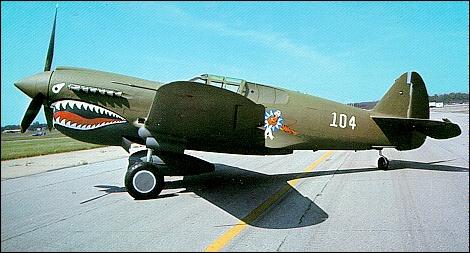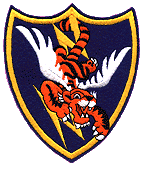CURTISS P-40E "WARHAWK"
 The P-40, developed from the P-36, was America's foremost
fighter in service when WW II began. P-40s engaged Japanese aircraft during the attack on
Pearl Harbor and the invasion of the Philipines in December 1941. They also were flown in
China early in 1942 by the famed Flying Tigers and in North Africa in 1943 by the first AAF
all-black unit, the 99th
Fighter Squadron.
The P-40, developed from the P-36, was America's foremost
fighter in service when WW II began. P-40s engaged Japanese aircraft during the attack on
Pearl Harbor and the invasion of the Philipines in December 1941. They also were flown in
China early in 1942 by the famed Flying Tigers and in North Africa in 1943 by the first AAF
all-black unit, the 99th
Fighter Squadron.
The P-40 served in numerous combat areas--the Aleutian Islands, Italy, the Middle East,
the Far East, the Southwest Pacific and some were sent to Russia.
Though often outclassed by its adversaries in speed,
maneuverability and rate of climb, the P-40 earned a reputation in battle for extreme
ruggedness. At the end of the P-40's brilliant career, more than 14,000 had been produced
for service in the air forces of 28 nations, of which 2,320 were of the "E"
series.
The airplane shown here, a "Kittyhawk" (the export version of the P-40E built
for the RAF), was obtained from Mr. Charles P. Doyle, Rosemount, Minnesota and is on
display at the U. S. Air Force Museum. It is painted as the P-40E flown in combat by Bruce Holloway, a pilot in both the Flying Tigers
and its successor AAF unit, the 23d Fighter Group. During his tour in China, Colonel
Holloway, who retired as a fourstar general in 1972 while the Commander of the Strategic
Air Command (SAC), had a total of 13 Japanese planes to his credit.

23rd Fighter Group patch
Courtesy U. S. Air Force Museum

SPECIFICATIONS
Span: 37 ft. 4 in.
Length: 31 ft. 9 in.
Height: 12 ft. 4 in.
Weight: 9,100 lbs. loaded
Cost: $45,000
ARMAMENT
Six .50-cal. machine guns; 700 lbs. of bombs externally.
PERFORMANCE
Engine: Allison V-1710 of 1,150 hp.
Maximum speed: 362 mph.
Cruising speed: 235 mph.
Range: 850 miles
Service Ceiling: 30,000 ft.
U.S.Fighter
Home | Feedback
 The P-40, developed from the P-36, was America's foremost
fighter in service when WW II began. P-40s engaged Japanese aircraft during the attack on
Pearl Harbor and the invasion of the Philipines in December 1941. They also were flown in
China early in 1942 by the famed Flying Tigers and in North Africa in 1943 by the first AAF
all-black unit, the 99th
Fighter Squadron.
The P-40, developed from the P-36, was America's foremost
fighter in service when WW II began. P-40s engaged Japanese aircraft during the attack on
Pearl Harbor and the invasion of the Philipines in December 1941. They also were flown in
China early in 1942 by the famed Flying Tigers and in North Africa in 1943 by the first AAF
all-black unit, the 99th
Fighter Squadron. 
